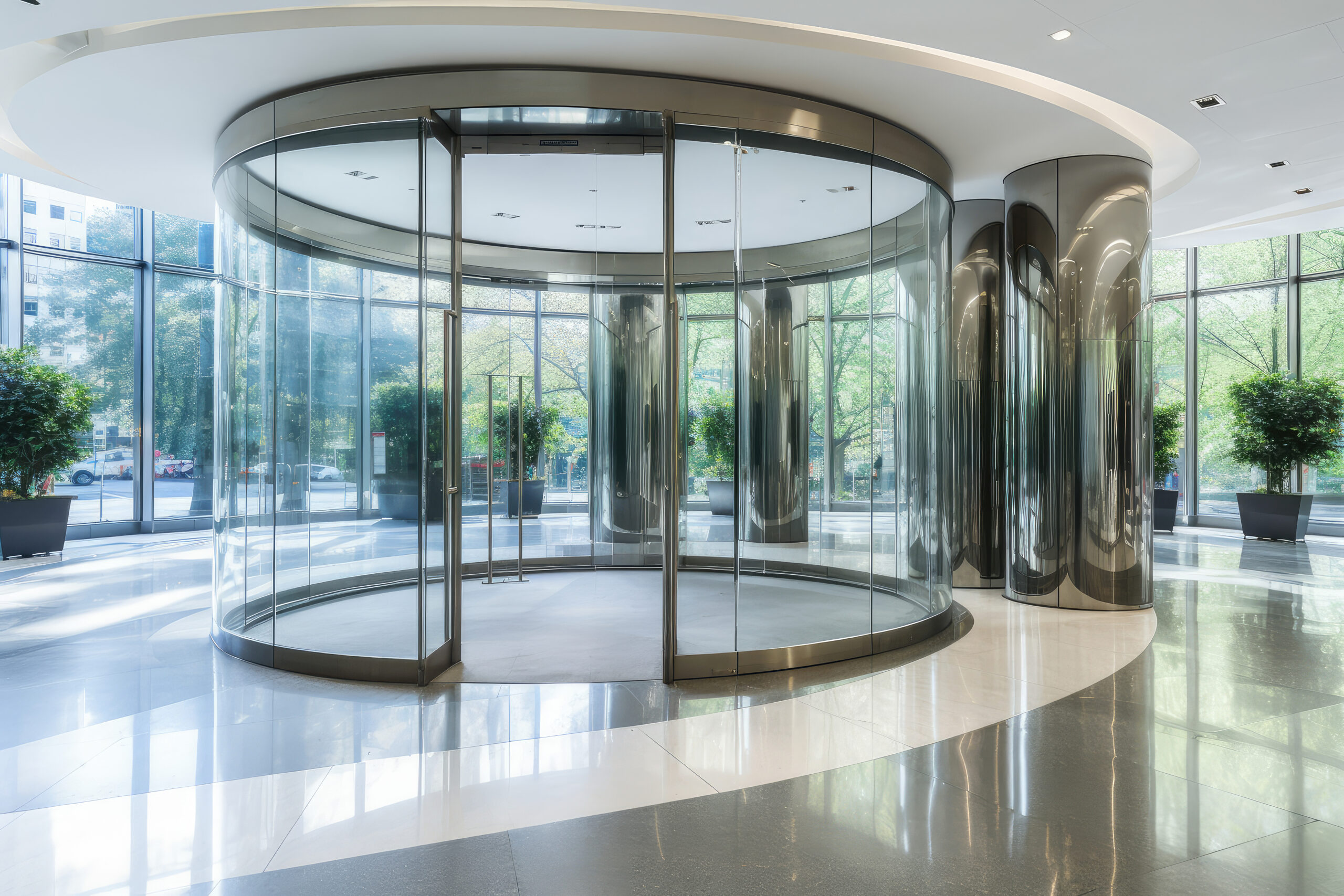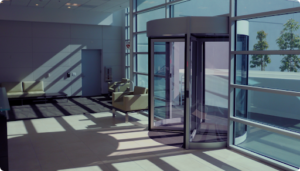If someone brings up modern architecture in a conversation, what words immediately come to mind? Contemporary designs, charming architectural constructions that blend with the surrounding environment, and the spectacular circular doors of each facility’s entrance. Automatic doors are more than just a stylish way to enter a building. Today, however, it will be interesting to look at the abundant benefits associated with the use of revolving doors, which is why they remain a staple of modern architecture and design.
The Mechanics Involved with Revolving Doors
They are a hardware feature that, at heart, is an architectural masterpiece. Imagine several circular or semi-circular panels with cylindrical casings which revolve around a common axis. This is not just a cosmetic feature; it lets people out and lets people in at the same time, making proper circulation of foot traffic possible. Additionally, they create a more classy appeal to any building facade they incorporate. From a security point of view, revolving doors are simply perfect. They can regulate the inflow and outflow of people, making it difficult for unauthorized people to sneak in. This is why it is quite common to see them on-premises with much emphasis on security, such as firms and classy hotels. Of course, one has to mention the looks of a revolving door. However, a turnstile door is uniquely futuristic and glossy, making it an excellent accent for the architecture of any facility.
What Difference Do Revolving Doors Make?
Revolving doors offer bounteous advantages that can transform any building in various ways. Here’s a closer look at what they offer:
Energy Efficiency Benefits
1. Thermal Insulation
Another advantage of using revolving doors is the improvement in thermal insulation. Unlike swing or sliding doors that allow fresh air into the building, revolving doors minimize openings, thereby filtering out fresh air. This means fewer heat escapes in winter and less heat penetrates the building in summer, helping regulate the internal temperature and reducing the load on air conditioning systems. This is a clear trade-off between energy efficiency and sustainability.
2. Airflow Control
Revolving doors also enhance airflow control. They prevent exterior air from penetrating the interiors, thereby limiting the introduction of dirt, pollutants, and other adverse external elements, which is vital in commercial buildings, densely populated areas, and busy corridors. Additionally, revolving doors form an effective barrier, preventing unhealthy air from entering indoors.
3. Noise Reduction
Noise pollution in busy urban areas can be problematic. Revolving doors help mitigate this issue by acting as a sound barrier that lets in less noise, making the indoor environment quieter. This is particularly beneficial for buildings located near busy streets with heavy traffic noise.
Safety and Security
1. Controlled Access
Revolving doors enhance building security by restricting the flow of people. Unlike conventional doors, revolving doors cannot be left half-open or easily forced open, which improves security and reduces unauthorized entry. This is why they are commonly used in secure areas such as offices and airports.
2. Traffic Management
Revolving doors manage crowd circulation and regulate the flow of people, even during rush hours. They prevent congestion and keep pathways clear, which is essential in facilities such as malls, convention centers, and transportation hubs where effective crowd management is crucial.
3. Emergency Egress
Contrary to popular belief, revolving doors are designed to serve during emergencies. Modern systems include features like foldable wings or break-out devices that facilitate easy evacuation. These innovations ensure compliance with safety measures and provide a reliable escape route in case of an emergency.
Beauty and Functionality or Versatility
1. Architectural Statement
In addition to their performance benefits, revolving doors are impressive ornamental structures. They come in various materials, finishes, and designs, allowing them to blend with almost any architectural style. Whether you desire a contemporary, polished look or a traditionally elegant appearance, revolving doors make a significant impact on guests.
2. Space Optimization
Revolving doors are space-savers. Unlike swing doors that require ample space to open, revolving doors occupy a very small area of floor space while allowing smooth traffic flow. This is especially beneficial in structures where space is limited, resulting in efficient use of the available space.
Sustainability and Long-Term Value
1. Durability and Maintenance
Revolving doors are built with resilience in mind, using long-lasting materials and high-quality mechanical parts. They require minimal maintenance due to their robust construction, which allows them to withstand regular use and exposure to the elements. These long-lasting structures can remain functional for many years, and their maintenance and inspection are cost-effective for building owners.
2. Environmental Impact
Revolving doors promote eco-friendly building practices by reducing energy consumption and operational expenses. They help decrease energy usage, lower carbon footprints, and enhance overall building functionality, aligning with global trends toward environmental conservation and energy-saving objectives.
Find out about the perfect revolving door systems from Mace Gulf
At Mace Gulf, we offer quality revolving doors that enhance both the security and beauty of your building’s main entrance. Our doors are ideal for handling heavy traffic while being energy-efficient. Perfect for public, corporate, and commercial facilities, our revolving doors can be custom-designed to meet individual clients’ requirements, with a primary emphasis on functionality and security for building occupants. Our expertise and dedication to client satisfaction ensure that our services harmonize with your architectural plans. Contact Mace Gulf today to schedule an appointment and discover how we can revolutionize your building’s entrance.
Conclusion
Revolving doors provide the best of both worlds in terms of functionality, security, and aesthetics in modern construction. They offer numerous advantages, including energy efficiency, improved air quality, enhanced security, and architectural beauty. Revolving doors will always be a staple of modern architecture and interior design, with efficiency, convenience, and user satisfaction being priorities for architects and building owners.
Frequently Asked Questions
Find answers to the most common questions about our revolving doors, their functionality, and their applications.
In what way does the use of revolving doors assist in energy conservation?
Researchers have confirmed that revolving doors form a seal upon the entry and exit of people, preventing the infiltration of fresh drafts of air and retaining air conditioning within buildings. This reduces heating and cooling costs, ensuring the internal environment maintains a constant temperature, which is especially beneficial for places with high foot traffic.
What safety features do revolving doors include?
Newer versions of revolving doors include various safety features: speed-regulating mechanisms, emergency shut-off buttons, and sensors that detect objects in the way. These features act as safeguards to address any incidents and ensure the safe usage of revolving doors.
How do revolving doors contribute to building security?
Revolving doors improve security by controlling access. They can be connected with access control systems such as card readers, fingerprint scanners, or facial recognition devices, allowing access only to authorized individuals. This ensures that only those with special permissions can enter the building.
Can revolving doors be useful in emergencies?
Yes, many revolving doors include features like breakaway panels or foldable wings that enable users to quickly and effectively evacuate the building during an emergency. Some systems also allow the doors to be unlocked if the building’s alarm sounds.



